Menu
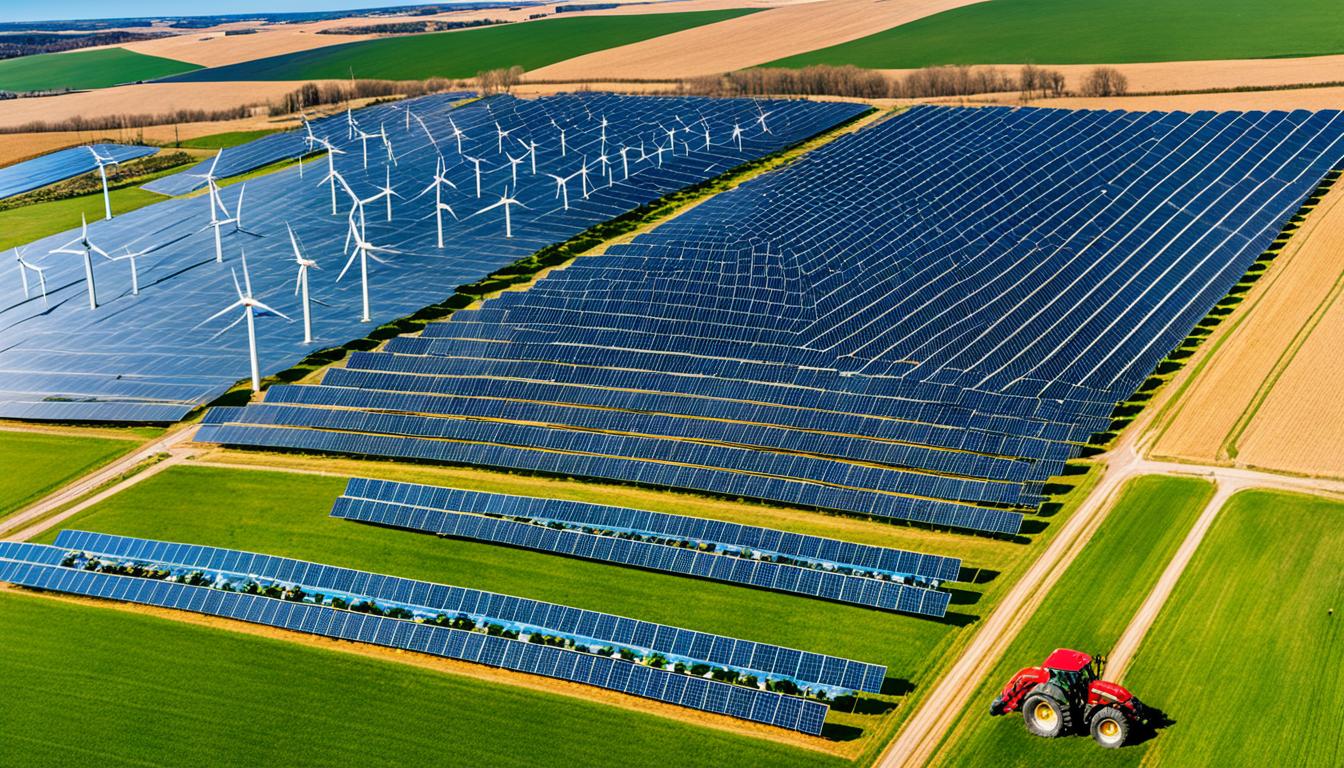
Did you know wind energy could create 80,000 new jobs and $1.2 billion for farmers and rural folks? The farming world is moving towards renewable energy to stay green and profitable. It’s a big change for a field that once used a lot of energy.
Farmers are welcoming solar power, wind energy, and biofuels eagerly. These types of energy mean lower utility costs, more independence, and less harm to the planet. They’re not just good for individual farmers – they can also help power local areas and boost the economy.
There’s help available too, from programs like the Rural Energy for America Program (REAP) and the Bioenergy Program for Advanced Biofuels. These aid farmers in making the shift to cleaner energy easily. It’s a win for the earth and the pocket.
Renewable energy is key for farm growth. It helps the planet and makes farms more stable economically. Farming with eco-friendly tools reduces harm to the environment and cuts costs long-term.
Wind, solar, and biomass cut down on harmful emissions. They lessen the need for fossil fuels, which is great for the planet. Using solar for heating, for example, lowers costs by up to 85%.
Switching to renewable energy can boost farm earnings. More biomass could create $20 billion in new money. Wind power offers a big chance for farm owners to earn extra, too.
Renewables also help farms save money. Government programmes assist with the costs of these green technologies. This helps farmers spend less on their power.
| Renewable Source | Investment Range | Economic Benefit | Key Incentives |
|---|---|---|---|
| Solar Power | $13,000 – $40,000 (for residential systems) | Reduces electricity bills, potential for surplus energy income | Investment Tax Credit (ITC), REAP |
| Wind Energy | $13,000 – $40,000 (for residential systems) | Provides additional revenue from selling electricity, job creation | State-level rebates, federal incentives |
| Biofuel Production | $400 – $13,000 (oil presses) | Reduces heating costs by up to 85%, potential new income sources | EQIP, State energy rebate programmes |
It’s smart for farmers to keep up with new funding options. Places like the DSIRE site help them find the best deals. This makes for strong farms that also help the Earth.
Solar power is a key player in providing renewable energy for farms. It shines in the quest for sustainable farming. More and more farmers are choosing solar energy to run their farms, save money, and help the planet.
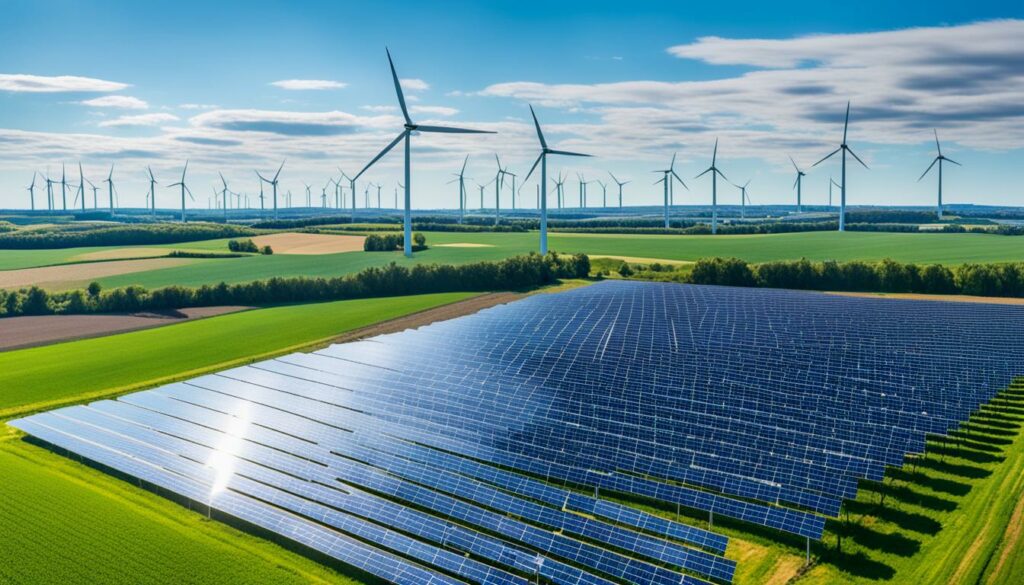
Solar panels are being set up on farm lands to capture the sun’s power. They can be placed on barns, in fields or spaces left for animals and plants. The U.S. has 314 projects like this, with over 2.8GW of solar energy. This smart use of land fits well with farming.
The panels are spaced out to let farm vehicles move around easily. This setup lets solar energy and farm work happen smoothly together.
Putting in solar panels costs a bit at the start but saves a lot over time. There are tax breaks like the 30% credit for those who install them. Once they’re up, they cost little to keep running and last for many years.
Also, farmers can make money by selling extra power. This keeps their financial fields fertile and supports green farming.
Cases show that solar and farming activities can work together well. This ‘agrivoltaics’ helps reduce land fights and brings big eco wins. There are efforts like SETO and FARMS that look into how these solar-farm combos grow both crops and power.
Imagine, the U.S. can host up to 27 terawatts of solar power on farm land. Even if only a small part of farms use solar by 2035, it’s a big step in green farming. Solar energy not only powers farms but makes them more efficient, saving water and facing up to tough weather.
Wind energy is a big step in going green for farms. Farmers now look to wind turbines, especially in places with lots of wind. This is because wind turbines can make a lot of energy.
Finding the best spots for wind turbines matters a lot. They work best where there are class 2 winds, between 9.8 to 11.5 mph. In these places, wind turbines can make a great amount of electricity. This electricity can really help farms.
| Wind Turbine Specification | Details |
|---|---|
| Class 2 Wind Requirement | 9.8 to 11.5 mph sustained wind speeds |
| Cost per Kilowatt | $4,000 to $8,000 |
| Federal Incentive | 30% Investment Tax Credit |
| Expected Turbine Lifespan | 20 years |
Adding wind turbines to farms is a smart move. They can power the farm or sell extra electricity. This can bring in more money and cut down on energy bills. It helps farms be more financially stable.
Special government help, like from the REAP, can cover part of the cost. Some programmes help with up to 75% of the cost. This makes it easier for farmers to start using wind power.
This change to wind energy is not just good for farms. It helps make farming more sustainable. It’s a step towards a future with cleaner energy for everyone.
Biofuels play a key role in making farming more sustainable. They offer an earth-friendly option to the usual fossil fuels. This includes stuff like biodiesel and ethanol. These come from crops like corn and even grass.
Farmers find they can make a big difference by using biofuels. They can make their own energy. Plus, it helps them keep their fuel costs steady, which is vital for the future of farming.
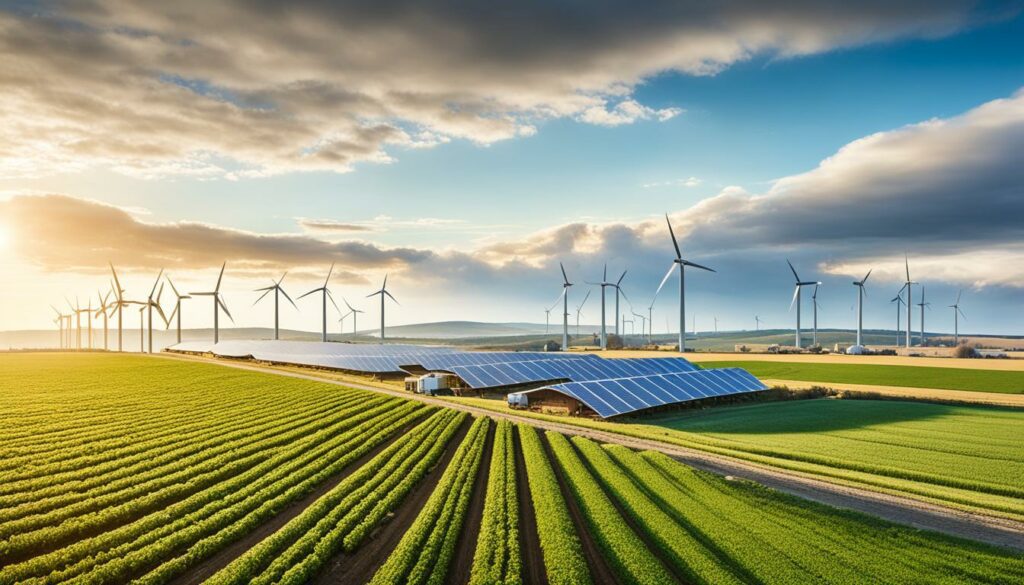
There are mainly two types of biofuels: ethanol and biodiesel. Ethanol comes from plants such as corn and has really boomed in the U.S. over the last 20 years. On the other hand, biodiesel comes from oilseed crops. It saves money on the farm and also makes a valuable by-product.
Creating these biofuels is important for the planet. Ethanol comes from a fermentation process. And biodiesel is made by a process called transesterification. Even though making biofuels can sometimes compete with making food, it also brings in a lot of money. For example, making energy from plant material could bring $20 billion to farmers and their local areas.
There are, however, some issues with biofuels. For example, biodiesel can act up in cold weather. And it can leave a kind of dirt when stored for a while. But, with hard work and new tech, we can make this process better. This is key to keeping farming kind to the planet.
| Type of Biofuel | Primary Crop Source | Market Value | Challenges |
|---|---|---|---|
| Ethanol | Corn | Moderate to High | Competition with food production |
| Biodiesel | Oilseed Crops | High (because of meal by-product) | Poor cold weather performance |
Agrivoltaics is the mix of agriculture and solar energy> on the same land. It’s a smart way to support sustainable farm methods. With renewable energy now joining in, there are big pluses for growing crops and creating power.
By last year, 12% of the U.S.’s energy came from renewables. Experts think by 2035, solar could meet 40% of the country’s power needs. This shows a big move towards using the sun for farming energy.
Farming covers a lot of the U.S.’s land – about 43%. Using agrivoltaics makes better use of this space. By 2050, we might only need 0.5% of the land for solar panels.
In Rockport, Maine, a 10-acre solar farm helps grow blueberries. It’s a top example of using renewables in farming. It boosts crop growth, saves water, and makes a lot of energy.
The U.S. Department of Energy helps 22 projects in the country. Teams at the University of Massachusetts and elsewhere study how solar and farming can work together. They look at making solar farms friendly for bees and other pollinators.
The University of Vermont also teaches about solar and farming. These efforts are key for technology and green farming to grow.
| Institution | Focus |
|---|---|
| University of Massachusetts Amherst | Co-location of solar panels and agriculture |
| Cornell University | Pollinator-friendly plantings, sheep grazing |
| Rutgers University | Agrivoltaic systems testing |
| University of Vermont | Workshop on solar energy in farming |
Research keeps looking at how solar farms affect the soil, what plants work best with solar panels, and how animals and solar can mix. They aim to make agrivoltaics better for farming and the planet.
Green energy solutions for farmers come from geothermal energy. They use heat from the Earth for heating and cooling. This method has been used for a very long time. People first used it over 10,000 years ago for basic needs like keeping warm and cleaning. Today, it’s essential for eco-friendly farming initiatives.
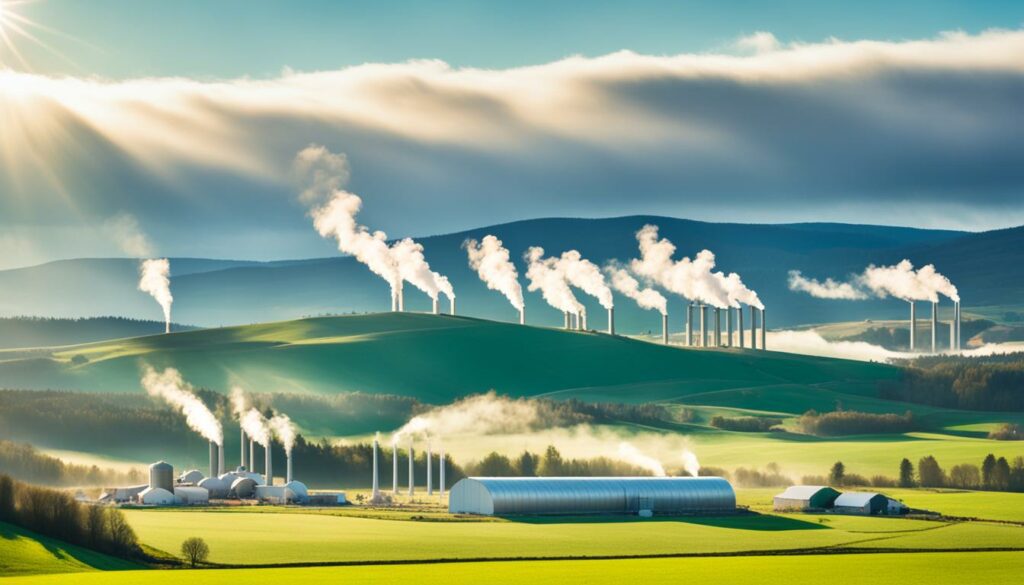
Geothermal energy is efficient. Heat pumps using this energy can cut energy costs by up to 60%. This is great news for farmers. It means they can save money and help the environment. They can even grow more crops because of this technology.
In places like Kenya, companies are using geothermal energy for growing flowers. Oserian has been doing this since 2003. It’s good for the environment too, cutting carbon footprints by up to 95% when compared to other drying methods.
Around the world, geothermal energy use went up by 24% by 2014. It’s being used for many things. This includes heating greenhouses, aquaculture, and industrial processes. This growth shows it is valuable and becoming more popular.
Using geothermal energy in greenhouses means crops can grow faster. These systems provide a steady temperature. Unlike relying on the weather, they create the perfect environment for plants. This makes the crops better and more plentiful.
| Applications | Benefits | Statistics |
|---|---|---|
| Heating Greenhouses | Faster and more reliable crop growth | 15% increase in usage from 2010 to 2015 |
| Flower Production in Kenya | Extended growing season, increased profits | Used by Oserian since 2003 |
| Crop Drying | 95% reduction in carbon footprint | Common method in the USA, China, Hungary |
About 12% of all energy goes into growing crops. Most of this is used after the crops are harvested. The farming industry uses a lot of water too. Geothermal energy can reduce the impact of these activities on the planet.
The success of geothermal systems can depend on the ground they’re in. Some places need more work than others. Choosing the site carefully ensures the best results from geothermal energy.
Hydropower is a great way for farmers to use clean energy from water. It works well where there are rivers or streams. By using the force of the water, it can provide much of the power needed on farms.
This power is steady and doesn’t run out, making it great for the future. It’s a smart choice for those planning for the long term.
To set up hydropower, you need streams or rivers. This method is often chosen because it’s cheaper and needs less upkeep. In places like Colorado, farms can use this to power a lot of land.
Small systems, which can make up to 2 MW, are ideal for farms. They last for many years, cutting down on costs. They help make farms more self-sufficient in energy.
Here’s a look at how long it takes and what it costs to start up renewable energy sources on farms:
| Energy Source | Initial Cost | Payback Time | Lifespan |
|---|---|---|---|
| Geothermal | $10,000-$30,000 | 5-10 years | 50+ years |
| Small Hydropower | $1,000-$20,000 per kW | 5-15 years | 20-25 years |
| Solar Water Heaters | $2,000-$6,000 | 3-7 years | 15-20 years |
| Wind Energy | $13,000-$40,000 | 10-15 years | 20-25 years |
Adding renewable energy to farms helps both the planet and the wallet. It can save money through net metering. This lets farmers use extra energy later without extra cost.
Colorado is ahead in supporting small hydropower. Laws like Colorado HB14-1030 make it easier to get started. Choosing the right place and system can really help farms.
Biomass energy plays a big role in making farming eco-friendly. It changes waste into energy, which solves waste problems. This energy creates heat and power on farms. This helps save resources and reduces the gases causing climate change.
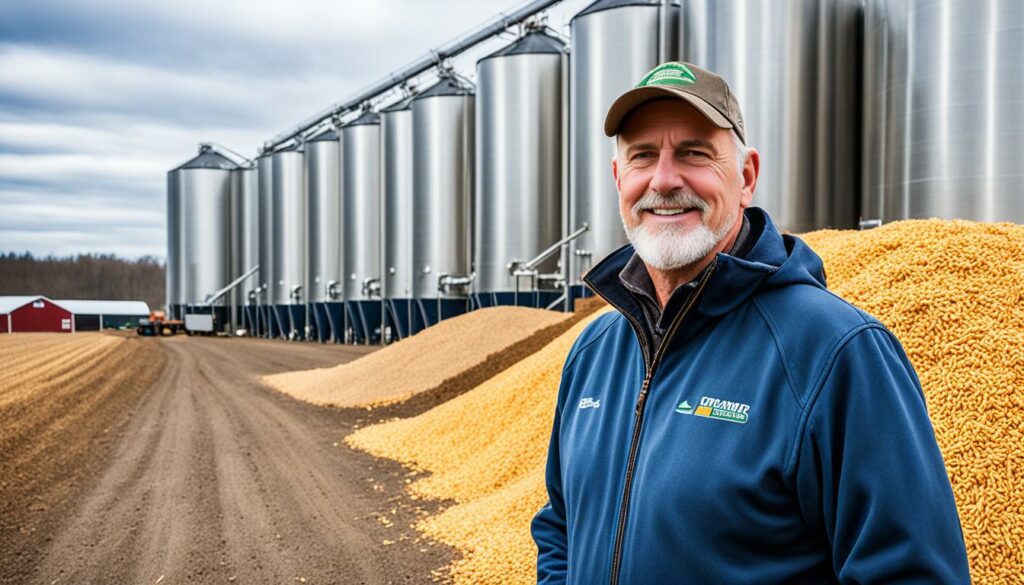
Biomass energy brings big financial benefits. If the U.S. used biomass more, it could make farmers and rural areas earn $20 billion extra. For example, using biofuels can lower heating bills on a dairy farm by 85% each year. The government supports this with $49 million a year for five years. This money goes to making better technology for biomass and growing energy crops.
Despite its benefits, there are challenges to using biomass energy more. Problems like not having enough materials to make energy and the high cost of equipment can be tough. Let’s look at some solutions:
Using renewable energy, especially biomass, in farming benefits the environment. It ensures farms are sustainable both in making money and protecting nature.
Getting funds and incentives is key for using renewable energy in farming. It helps improve crop-growing methods and makes them more green. The help comes from both national and local governments. This support makes it possible for farmers to start new projects.
The US government has many programmes that help with renewable energy. For example, the Rural Energy for America Program (REAP) gives out loans and grants. In 2024, REAP loans get an 80% guarantee, and grants can pay for half the project’s cost. Plus, the Inflation Reduction Act adds more money to REAP. This makes investing in green energy and saving energy easier for farmers. But, costs you paid before applying are not covered. Also, you must control the project area for its whole useful life.
States also have their own projects that help farmers go green. In Wisconsin, Focus on Energy gave over $2 million in bonuses to 880 farms in 2022. This led to savings of $3.5 million on energy bills. The aim is to help cut down on energy waste and use more renewable energy. Farmers can get support not just from one programme but many. For example, a project can have funds from REAP, Focus on Energy, and PACE loans. This can pay for the whole project cost.
There are many ways to get money for green projects. PACE loans are one option. They can be from $100,000 to $50 million, for 5 to 30 years. The interest is about 5.0% to 7.0%. Often, the savings on energy bills are more than what you pay back. But, you need permission from your mortgage lender to get a PACE loan.
Working with government bodies and tax professionals is smart. It helps farmers use all the funding they can. This makes using renewable energy more popular on farms and helps farming stay greener.
| Program | Maximum Grant Amount | Additional Information |
|---|---|---|
| REAP | $1 million for RES, $500,000 for EEI | Requires environmental reviews before construction; no lease to own |
| Focus on Energy | Varies by product type | Funding available within 60 days post-installation |
| PACE Loans | $50 million | Terms between 5 to 30 years; requires lender consent |
The future of farming is being shaped by technological innovations in renewable energy. These innovations allow farmers to use resources more precisely. This boosts both their productivity and sustainability.
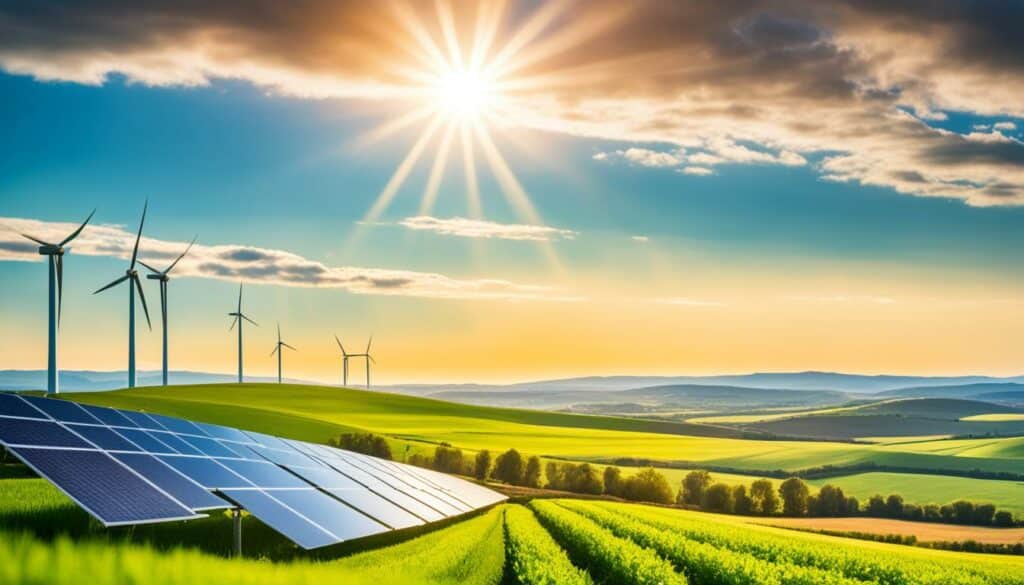
The use of sensors and the Internet of Things (IoT) is a major step forward. These tools keep an eye on soil, moisture, and plant health in real-time. This helps farmers make smarter choices about how they use resources. Machine learning and artificial intelligence (AI) make these tools even more powerful. They offer predictions that help farmers get the most from their resources and increase crop yields.
Energy storage technology is also making big strides. Better batteries and connections to the power grid are making renewable energy more reliable and efficient. With these new tools, farms can save and use their own energy, providing a steady power supply when energy generation is low.
Wind power could bring about big changes, with projections of creating 80,000 new jobs and adding $1.2 billion in income. An individual turbine can bring in anywhere from $2,000 to $5,000 each year. Despite needing less than half an acre of land, wind power is proving to be quite profitable.
Solar power is another key player, making energy bills smaller and farms more self-reliant. Every day, the sun provides more energy than we could ever use. This makes it a great choice for farms, supported by state programs and funds.
The U.S. Department of Energy says that using more biomass energy could earn up to $20 billion for people in farming and in rural areas. It could also reduce as many emissions as taking 70 million cars off the road. Biofuels offer a greener way forward, providing another source of income and cutting the need for fossil fuels.
There are federal incentives, like those from the 2002 Farm Bill, that help farmers invest in renewable energy. The Inflation Reduction Act has made these programs even better, upping the funds and who can apply for them. This encourages more farmers to turn to sustainable energy solutions.
In conclusion, technology is changing how farmers approach renewable energy. From AI to better ways of storing energy, these changes are moving farming towards a more sustainable future. By adopting these new technologies, farmers can not only improve how they work but also help make agriculture more eco-friendly.
Using renewable energy in farming can have big economic advantages. It cuts costs and opens new ways to make money. By using less traditional energy, farmers can pay less for electricity. This drops how much they spend on their farms.
Joining schemes like the Rural Energy for America Program (REAP) can pay for half of a project’s cost. Also, a mix of grants and loans can pay for 75% of the expenses. With Investment Tax Credits (ITC), you can lower your federal income tax by 30% if you use solar power. These steps save a lot of money, making it easier to use renewable energy in farming.
Farmers can earn money by making more energy than they need. Selling extra power to the grid can be profitable. It adds to the farm’s income. Programs like the Small Business Advantage Grant (SBAG) give back some of the money for making energy use better. This helps farms earn even more.
These benefits help farms stay sustainable and keep making money. As more renewable energy is used, the economic advantages are clear. It’s a firm step towards a better future for agriculture.
| Programme | Benefit |
|---|---|
| REAP | Up to 50% cost coverage for projects; 75% with combined grants/loans |
| ITC | 30% reduction in federal tax liability for solar systems |
| SBAG | Partial reimbursement for energy efficiency improvements |
Using renewable energy in farming brings big environmental benefits. It helps fight climate change by cutting down on greenhouse gases. This protects our planet and saves important natural resources.
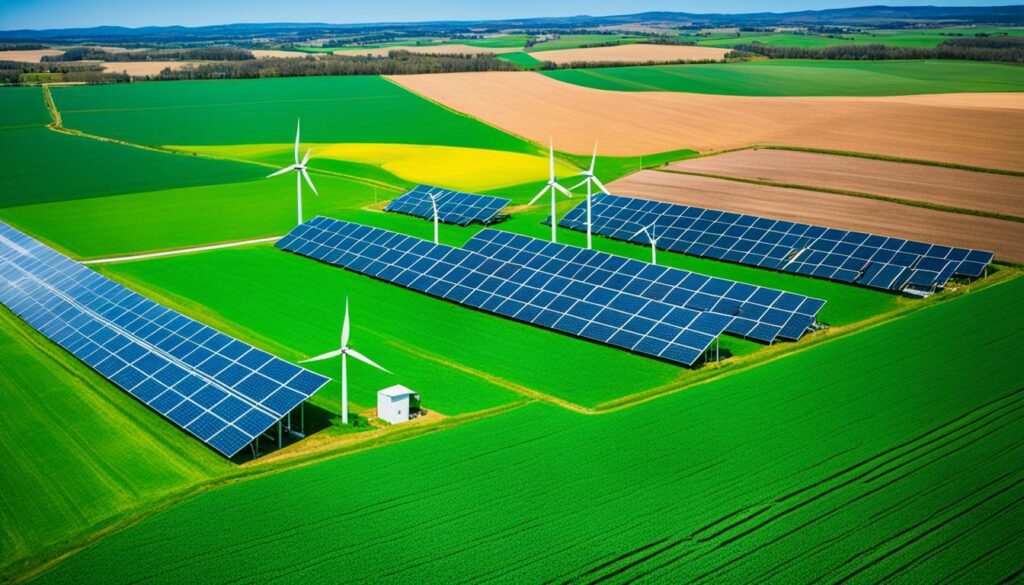
Solar power is easy to get and helps farms save a lot on electricity. Wind energy does the same, but it needs steady winds. Both lower the need for fossil fuels and reduce the farm’s carbon footprint.
There are funding programmes that support using renewable energy. The REAP can fund half of a project’s costs. The ITC cuts down income taxes by 30% for solar projects. This help encourages farms to go green.
Also, making biofuels from crops like corn lowers the need for oil. It helps feed a cycle that cuts out emissions, like taking 70 million cars off the road. Biofuels show a big step towards a cleaner farming future.
But, we have to handle renewable energy in farming carefully. Wind turbines can be harmful to birds and bats, which has led to studies on making their blades safer. Solar farms might affect local wildlife habitats. So, careful planning is needed to make sure going green doesn’t harm nature.
Learning how farms transition to renewable energy helps us see the real-world pros and cons. These stories show us different ways renewable energy helps and changes farming worldwide.
Take Black Star Farms, for instance. They put a 53.04 kW solar system in place, cutting 90% of their tasting room’s electricity needs. This setup cost them $201,443, but their total expenses were higher, at $219,701 due to grants and permits. The farm managed to get $92,145 from external sources, helping a lot. They expect to see their money back in nine years.
The farm bosses said the setup was easy, thanks to Cherryland Electric Co-op and GreenStone. Also, their customers liked their move to clean energy. This shows going green doesn’t just save money but also builds a good brand image.
From Black Star Farms, we learn a few key things. Good financial planning and finding extra money make the start easier. Also, checking your energy use before you start can point you to the most effective areas to change.
In other parts of the world, we see great steps too. Iceland gets over 85% of its power from renewables, and Portugal went 149 hours straight on just clean energy. These achievements highlight the big and positive change renewable energy can bring, for example, Uruguay’s almost 98% renewable electricity comes mostly from green sources.
A closer look at these successful farms can give others good ideas. Whether it’s through solar, wind, or biomass, people are seeing that choosing green pays off in many ways. This is both good for the pocket and the planet.
Despite excitement for renewable energy, challenges exist. Farmers struggle with the costs to start. Just in 2022, solar power investments hit nearly US$500 billion. With big money up front, getting loans with higher interest rates adds more cost worry.
Farmers find it hard to start using solar and wind power due to the high costs. In 2022, more money went into solar power, but less into wind. Global efforts don’t yet meet the goal to limit global warming. These obstacles suggest the need for help through grants, subsidies, and low-interest loans.
Installing and keeping up with renewable technology is not easy. For example, geothermal energy has limited use based on location. Using smart grids or virtual power plants needs special skills. Better policies are also needed to help. So, farmers must get help from experts to handle all these.
To solve these problems, we need to think long-term. Working together and improving our knowledge are key. With the right help and planning, we can move to green energy smoothly. This change will not only help the planet but also our wallets.
Farming with renewable energy cuts greenhouse gases. It lessens the need for oil, fighting climate change and keeping nature safe.
Switching to renewable energy means cheaper electricity. Farms can become self-sufficient and even make money selling extra energy. This boosts farm earnings and green credentials.
Solar panels on barns or fields need thinking about where to place them. Costs, upkeep, and getting enough sun are key. But, you can save a lot and maybe earn through schemes like net metering.
Turbines work best where the wind is steady and strong. Check the wind and think about the land and what’s already there. This way, turbines give more clean, green power.
Biodiesel and ethanol from plants like corn are main options. They’re green alternatives to petrol, making farms more self-sufficient.
Agrivoltaics combines solar power with farming. It helps crops and animals, saves water, cuts costs, and adds to farm income in new ways.
Geothermal heat pumps can heat and cool things using the earth’s underground heat. They cut energy use, supporting a green future for farms.
You need a flowing stream or river for hydropower. The right spot and care for nature are musts too. This way, you get clean energy without harming the environment.
Biomass turns waste into heat and power right on the farm. It’s efficient, cuts CO2, and is a great green energy choice for farms.
The government helps with the REAP and tax breaks, like the ITC for solar. These incentives make going green easier for farmers.
Sensors, IoT, and AI make energy use smarter. Better energy storage means reliable green power. This is shaping the future of farming.
Renewables save money, lower bills, and can even earn you cash. They make farms more financially stable and environmentally friendly.
Renewables cut gases and save earth’s resources. They clean the air, keep life diverse, and support sustainable farming.
Looking at farm examples offers lessons, successes, and ways to green up. It’s a roadmap for farmers moving towards a more sustainable future.
The road to green energy has costs, tech needs, and rules to follow. With help, know-how, and smart planning, farms can beat these challenges.